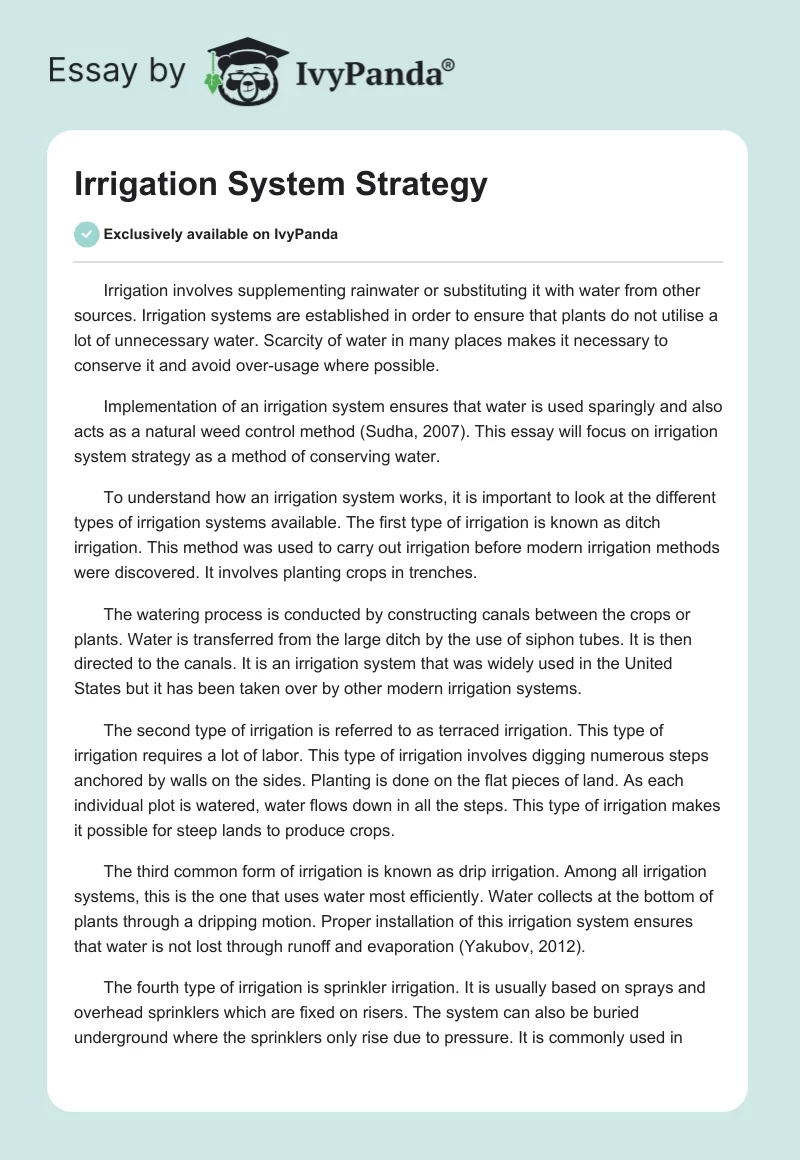Irrigation involves supplementing rainwater or substituting it with water from other sources. Irrigation systems are established in order to ensure that plants do not utilise a lot of unnecessary water. Scarcity of water in many places makes it necessary to conserve it and avoid over-usage where possible.
Implementation of an irrigation system ensures that water is used sparingly and also acts as a natural weed control method (Sudha, 2007). This essay will focus on irrigation system strategy as a method of conserving water.
To understand how an irrigation system works, it is important to look at the different types of irrigation systems available. The first type of irrigation is known as ditch irrigation. This method was used to carry out irrigation before modern irrigation methods were discovered. It involves planting crops in trenches.
The watering process is conducted by constructing canals between the crops or plants. Water is transferred from the large ditch by the use of siphon tubes. It is then directed to the canals. It is an irrigation system that was widely used in the United States but it has been taken over by other modern irrigation systems.
The second type of irrigation is referred to as terraced irrigation. This type of irrigation requires a lot of labor. This type of irrigation involves digging numerous steps anchored by walls on the sides. Planting is done on the flat pieces of land. As each individual plot is watered, water flows down in all the steps. This type of irrigation makes it possible for steep lands to produce crops.
The third common form of irrigation is known as drip irrigation. Among all irrigation systems, this is the one that uses water most efficiently. Water collects at the bottom of plants through a dripping motion. Proper installation of this irrigation system ensures that water is not lost through runoff and evaporation (Yakubov, 2012).
The fourth type of irrigation is sprinkler irrigation. It is usually based on sprays and overhead sprinklers which are fixed on risers. The system can also be buried underground where the sprinklers only rise due to pressure. It is commonly used in parks and golf courses. The pipes used can either be fixed permanently or mobile (Warrick, 1983).
However, in some situations they are fixed in a manner that allows them to move freely. The operations of the watering system are either automatic or partially automatic. The following diagram shows how sprinkler irrigation takes place.

Generally, the purpose of irrigation is to ensure that crops get enough water for growth. This is mostly applied in places where plants or crops are likely not to get enough rainwater. However, to maintain this balance excess water is used, causing some of it to become deep percolation.
Deep percolation is water that passes vertically through the water zone to deeper soil layers below the root zone of the crop. The water can also become surface runoff which is the water that does not enter the soil and flows off a lower portion of the field. Both deep percolation and surface runoff are not used by the crops.
The amount of water that is applied during irrigation depends on certain factors among them the type of the crop, variability and type of soil, field size, labor needs and the method used in applying the irrigation water to crops (Stine & Gerba, 2005). The irrigation system is expected to save up to 60 % of water that would have gone to waste had there been no irrigation.
Since water is a scarce commodity and not all farmers can afford irrigation, some farming methods can be used as alternatives. The first alternative to irrigation is crop rotation. This allows the soil to regain its fertility and also gives it a chance to retain enough water for the crops.
The second alternative that can be used instead of irrigation is no-till farming. This farming method allows farmers to till more acres since the method is not labor intensive. No-till farming is advantageous to farmers in that when the stubble from the crops harvested in the previous year is left in the fields, the soil collects the moisture from crops grown in the previous season.
In addition, the stubble creates a canopy that prevents the soil from the formation of a hard layer that inhibits penetration of moisture. These are some of the alternative methods that can be used instead of irrigation (Mishra & Kannan, 2012).
In order to understand how much water is saved by the application of irrigation systems, it is important to look at different irrigation methods and the methods they use to transport water from the source to the crops in the field. The efficiency with which various irrigation methods save water is based on the differences that define them.
This is because the physical qualities of various irrigation methods differ. The effectiveness of surface irrigation methods in saving water is determined by making a comparison between the amount of applied irrigation water and the amount of water required to refill the root zone of the crop.
When the amount of water that gets into the soil is more than the amount required to restore the soil moisture, the excess water becomes deep percolation. Surface runoff occurs when water is applied at a high speed that does not give it a chance to get into the soil completely.
Establishment of irrigation systems is an important way of boosting agricultural production. Irrigation has therefore been applied in different parts of the world. One of the countries where it has been widely used is China. The Chinese irrigation schemes are famous for their good design apart from being on a large scale.
The Chinese perfected the use of primitive techniques in irrigating their land, something that contributed towards the formation of fundamental farmland irrigation systems that were able to irrigate the land.
The systems have been a great success in China since they have boosted agricultural productivity remarkably. As a result, they have been spread throughout the country. Most of the irrigation schemes serve the functions they were designed for.
The cost of an irrigation system is determined by various factors and considerations. As a result, there is no standard cost. The first factor that determines the cost of an irrigation system is the type of irrigation method used. Different irrigation methods have different requirements with their unique costs.
There are also fixed operational costs which include taxes, insurance, depreciation and interests. Other factors that are factored in during the process of costing include pumping costs, since the water must be pumped from its source to the field (Hussein, 2000).
However, based on the above mentioned factors, it is possible to estimate the cost of the entire irrigation strategy. It is important to have an estimate of the total money required in order to look for it before the project starts. The whole project is estimated to cost $ 20,000.
Irrigation efficiency is determined when records of how crops use water during irrigation are studied. Accurate results are obtained when the studies are conducted for a certain period of time. These methods indicate that the various irrigation types save a lot of water that normally goes to waste.
During the implementation of the irrigation system, some problems are encountered. The first problem associated with irrigation is salinisation. This is the process through which salts build up in the soil until they become toxic for the survival of plants. Presence of salt in the soil is associated with decreased osmotic potential, which prevents the soil from absorbing water (Bordovsky & Eduardo, 2000).
Salty soil increases the solute concentration of the soil compared with that of the root, thus plants are unable to absorb water. In most cases, salinisation occurs when excess water is applied.
Water used in irrigation is usually rich in salts which are absorbed as it moves through the land. Rainwater is also rich in salts whose concentration is low in water. Instead of increasing productivity, salinisation leads to reduced productivity (Irrigation Systems, 2012).
Another problem that occurs as a result of irrigation is waterlogging. This occurs mostly in soils whose drainage is poor, making it difficult for water to penetrate into the soil. It also takes place in topographies that do not allow proper drainage to take place.
Water used in irrigation ultimately causes the water table to go up. Rise in the water table causes waterlogging of the soil. This fills air spaces present in the soil with water, leading to suffocation of plant roots due to lack of oxygen. In order to reduce salinisation and waterlogging, it is important to improve irrigation efficiency.
An irrigation system is one of the best strategies that should be implemented in Kingston suburb which is in Melbourne, Australia. As discussed earlier, water is a scarce resource that should be preserved and used sparingly. Kingston neighborhood is a suburb where many middle class people live.
Implementing an irrigation strategy is of great importance to this population since they can engage in productive agricultural activities. In addition, an irrigation strategy would ensure that they conserve the little water they have thus avoiding water shortages.
Another important reason why this strategy should be implemented in Kingston is that there are different types of irrigation patterns. Some of them do not require a lot of money and expertise knowledge to implement. This implies that the residents can work on the irrigation strategy successfully without incurring huge expenses or looking for experts to assist them. In addition, they can choose an irrigation strategy that suits their needs.
Through an irrigation strategy, the residents of Kingston suburb will be able get rid of some diseases associated with stagnant water. This is because the water that collects in trenches and shallow depressions will be harnessed and used for irrigation. Generally, it is a good strategy that will benefit the residents of the suburb once implemented.
Reference List
Bordovsky, J. & Eduardo, S., 2000, “Economic Evaluation of Texas High Plains Cotton Irrigated by LEPA and Subsurface Drip.” Texas Journal of Agriculture and Natural Resources, 15: 76-73.
Hussein, A. 2000, Principles of environmental economics. New York: Routledge. Irrigation Systems 2012. Web.
Mishra, A. & Kannan, K., 2012, Improving Existing Practices of Water Delivery in a Run-of-the-River Based Canal System for Better Water Use Efficiency. Irrigation and Drainange, 5: 30–340.
Stine, S. & Gerba, C., 2005, Application of microbial risk assessment to the development of standards for enteric pathogens in water used to irrigate fresh produce: Journal of food protection, 68: 913-918.
Sudha V., 2007, Reservoir Operation Management through Optimization and Deficit Irrigation. Irrigation and Drainage System, 55: 20-100.
Warrick, A.1983, Interrelationships of Irrigation Terms. Journal of Irrigation and Drainage Engineering, 109: 317-332.
Yakubov, M., 2012, Assessing Irrigation Performance from the Farmers’ Perspective: A Qualitative study, Irrigation and Drainage, 10: 316–329.


